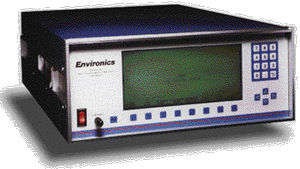Series 2020 CEMCS
The Environics® Series 2020 Continuous Emissions Monitoring Calibration System (CEMCS) automatically generates precise gas standards for rapid multi-point and multi-scale calibration of Continuous Emissions Monitors (CEM).
Download Full Datasheet for Series 2020 (pdf)
The Series 2020 precisely dilutes high concentration Protocol-1 or certified gas cylinders to an infinitely variable range of concentrations from high percents to low parts per million. The instrument meets or exceeds the performance requirements of the United States EPA 40 CFR Part 51 Method 205 Appendix M.
The Series 2020 consists of a single chassis supporting up to six (6) mass flow controllers (standard configuration), a serpentine pre-mix zone and a zero dead-space final mixing zone. Gas wetted surfaces are Electropolished 316 stainless steel. Seals are gas-compatible elastomer. User interface includes a back-lit 80 character by 25 line cold-cathode liquid-crystal display and membrane keypad.
The instrument's mass flow controllers are factory calibrated using a computer controlled primary flow standard traceable to the United States' National Institute of Standards and Technology (NIST). The calibration data consists of an eleven-point comparison of commanded versus actual flow with linear interpolation between the points.
The Series 2020 is available in a standard 19 inch rack mountable configuration for station or van usage or a portable bench-top version.
The optional RS-232 data interface permits remote or computer operation of the instrument.
- Broad range of dilution ratios (1:1 - 10,000:1, standard) allows the user to significantly reduce the number of gas cylinders needed to perform compliance tests.
- Broad dilution ratio capability allows calibration of most analyzer ranges from one cylinder of each gas, significantly reducing gas costs, transport and handling labor.
- Automatic calculation of dilution and span gas flows based on the concentration commanded by the user eliminates the need for manual computation and allows rapid transition from point to point and scale to scale.
- Internally-stored mass flow controller calibration data improves accuracy.
- High capacity memory permits storage and recall of up to 200 calibration "recipes", saving time and reducing errors.
- 25 line by 80 character display permits viewing of data in worksheet format.
- RS-232 Serial Data Interface permits remote operation and complete integration with a computer-controlled system.
- Automatically calculates K-factors using system gas library.
- Concentration Mode: User enters Target Output Gas Concentration (PPM or %) for the span gas. The actual concentration is displayed during mixing.
- Flow Mode: User enters Target Flow Rate (cc's per minute) for the span gas and dilution gas. Actual flow rates are displayed after mixing is initiated.
- Maintain Ports: User enters the name of the span gas in the source cylinder, its concentration (PPM or %) and the port to which it is connected.
- Status: (Optional) Allows user to remotely activate different modes of the system and also activate external devices.
- Automatic Sequencer: Permits unattended automatic operation of the instrument on a programmable seven-day schedule.
- Divider Mode: Allows the user to operate the instrument as a computerized 10 step gas divider.
- Accuracy
- From 10 to 100% of Full Scale Flow
- Concentration: ± 1.0%
- Flow: ± 1.0%
- Repeatability: 0.05%
- Warm up time: 30 minutes
- Gas connections: 1/4" Swagelok (or compatible fitting)
- Operating Pressures
- Minimum: 10 psig (0.67 Bar)
- Recommended: 25 psig (1.68 Bar)
- Maximum: 75 psig (5.04 Bar)
- Wetted Surfaces
- Tubing: Electropolished 316 Stainless Steel
- (Optional - Teflon, Hastelloy, Monel)
- MFC's: Stainless Steel (Optional - Hastelloy, Monel)
- Seals: Viton® (Optional - Kalrez®, Buna-N, Neoprene, Metal)
- Operating temperature: 32° - 122° F (0° - 50° C)
- Performance temperature: 59° - 95° F (15° - 35° C)
- Weight Minimum: 35 lbs. (16 Kg.)
- Maximum: 70 lbs. (32 Kg.)
- Dimensions (w x h x d)
- Portable: 17" x 7" x 23.5"
- (43.18 cm x 17.78 cm x 59.69 cm)
- Rack: 19" x 7" x 23.5"
- (48.26 cm x 17.78 cm x 59.69 cm)
- Standard: 115 VAC (100 to 130 VAC), 50/60 Hz
- Optional: 220 VAC (200 to 260 VAC), 50/60 Hz
- Current: 3 Amps (maximum)
- Inmos T 400 series, 32 bit processor
- 12 bit A/D and D/A conversion
- Front panel membrane keypad
- Internal timer control
- RS-232 terminal mode / Remote computer control (optional)
- Status board interface (optional)
- Other communications options available
- Optional RS-232 serial port / Parallel printer port interface
- Serial/Parallel Port Interface
- Status Board
- Additional Gas Circuits, Component or Dilution
- Purge System
- Solenoid Valve on Output
- Rack Mountable Case
- Heated Flow Path
- Humidification
- Pressurization

